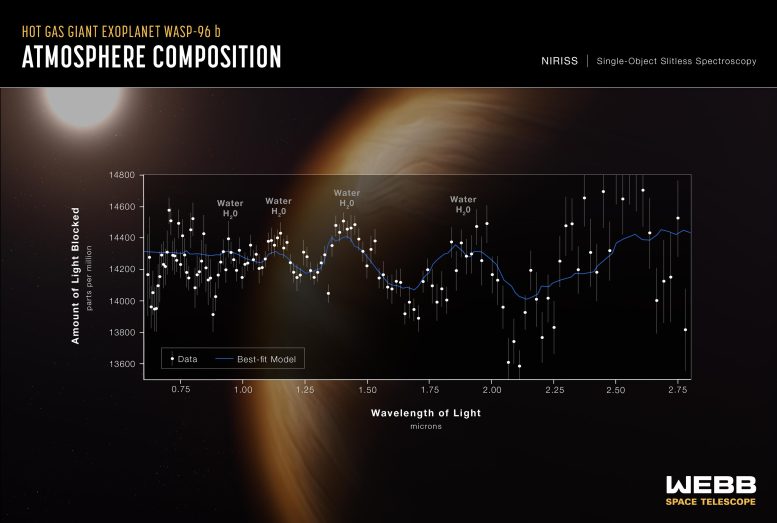
A transmission spectrum made from a single observation using Webb’s Near-Infrared Imager and Slitless Spectrograph (NIRISS) reveals atmospheric characteristics of the hot gas giant exoplanet WASP-96 b. A transmission spectrum is made by comparing starlight filtered through a planet’s atmosphere as it moves across the star, to the unfiltered starlight detected when the planet is beside the star. Each of the 141 data points (white circles) on this graph represents the amount of a specific wavelength of light that is blocked by the planet and absorbed by its atmosphere. Credit: NASA, ESA, CSA, ST
Webb’s Gigantic Mirror and Precision Instrumentation Join Forces To Capture the Most Detailed Spectrum of an Exoplanet Atmosphere Ever
In a remarkable dream come true for exoplaneteers, NASA’s James Webb Space Telescope has demonstrated its unprecedented capacity to analyze the atmosphere of an exoplanet more than 1,000 light-years away. With the combined forces of its 270-square-foot (25-square-meter) mirror, precision spectrographs, and sensitive detectors, Webb has – in a single observation – detected the unambiguous signature of water, indications of haze, and evidence for clouds that were thought not to exist based on prior observations. The transmission spectrum of the hot gas giant WASP-96 b, made using Webb’s Near-Infrared Imager and Slitless Spectrograph (NIRISS), offers just a glimpse into Webb’s exciting future of exoplanet exploration.
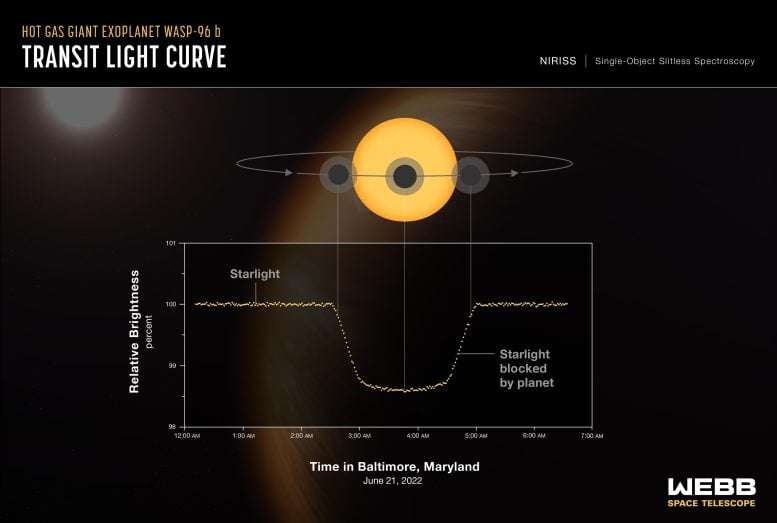
A light curve from Webb’s Near-Infrared Imager and Slitless Spectrograph (NIRISS) shows the change in brightness of light from the WASP-96 star system over time as the planet transits the star. A transit occurs when an orbiting planet moves between the star and the telescope, blocking some of the light from the star. This observation was made using NIRISS’s Single-Object Slitless Spectroscopy (SOSS) mode, which involves capturing the spectrum of a single bright object, like the star WASP-96, in a field of view. To capture these data, Webb stared at the WASP-96 star system for 6 hours 23 minutes, beginning about 2½ hours before the transit and ending about 1½ hours after the transit was complete. The transit itself lasted for just under 2½ hours. The curve includes a total of 280 individual brightness measurements – one every 1.4 minutes. Credit: NASA, ESA, CSA, STScI
Webb Reveals Steamy Atmosphere of Distant Exoplanet in Exquisite Detail
NASA’s James Webb Space Telescope has captured the distinct signature of water in the atmosphere surrounding a hot, puffy gas giant planet orbiting a distant Sun-like star. It also found evidence of clouds and haze.
The observation is the most detailed of its kind to date, demonstrating Webb’s incredible capability to analyze atmospheres hundreds of light-years away. It reveals the presence of specific gas molecules based on tiny decreases in the brightness of precise colors of light.
Over the past two decades, the Hubble Space Telescope has analyzed numerous exoplanet atmospheres , capturing the first clear detection of water in 2013. However, Webb’s immediate and more detailed observation marks an enormous leap forward in the quest to characterize potentially habitable planets beyond Earth.
WASP-96 b is one of more than 5,000 confirmed exoplanets in the Milky Way. Located roughly 1,150 light-years away in the southern-sky constellation Phoenix, it represents a type of gas giant that has no direct analog in our solar system. With a mass less than half that of Jupiter and a diameter 1.2 times greater, WASP-96 b is much puffier than any planet orbiting our Sun. And with a temperature greater than 1000°F, it is significantly hotter. WASP-96 b orbits extremely close to its Sun-like star, just one-ninth of the distance between Mercury and the Sun, completing one circuit every 3½ Earth-days.
The combination of large size, short orbital period, puffy atmosphere, and lack of contaminating light from objects nearby in the sky makes WASP-96 b an ideal target for atmospheric observations.
On June 21, Webb’s Near-Infrared Imager and Slitless Spectrograph (NIRISS) measured light from the WASP-96 system for 6.4 hours as the planet moved across the star. The result is a light curve showing the overall dimming of starlight during the transit, and a transmission spectrum revealing the brightness change of individual wavelengths of infrared light between 0.6 and 2.8 microns.
While the light curve confirms properties of the planet that had already been determined from other observations – the existence, size, and orbit of the planet – the transmission spectrum reveals previously hidden details of the atmosphere: the unambiguous signature of water, indications of haze, and evidence of clouds that were thought not to exist based on prior observations.
A transmission spectrum is made by comparing starlight filtered through a planet’s atmosphere as it moves across the star to the unfiltered starlight detected when the planet is beside the star. Researchers are able to detect and measure the abundances of key gases in a planet’s atmosphere based on the absorption pattern – the locations and heights of peaks on the graph. In the same way that people have distinctive fingerprints and DNA sequences, atoms and molecules have characteristic patterns of wavelengths that they absorb.
The spectrum of WASP-96 b captured by NIRISS is not only the most detailed near-infrared transmission spectrum of an exoplanet atmosphere captured to date, but it also covers a remarkably wide range of wavelengths, including visible red light and a portion of the spectrum that has not previously been accessible from other telescopes (wavelengths longer than 1.6 microns). This part of the spectrum is particularly sensitive to water as well as other key molecules like oxygen, methane, and carbon dioxide, which are not immediately obvious in the WASP-96 b spectrum but which should be detectable in other exoplanets planned for observation by Webb.
Researchers will be able to use the spectrum to measure the amount of water vapor in the atmosphere, constrain the abundance of various elements like carbon and oxygen, and estimate the temperature of the atmosphere with depth. They can then use this information to make inferences about the overall make-up of the planet, as well as how, when, and where it formed. The blue line on the graph is a best-fit model that takes into account the data, the known properties of WASP-96 b and its star (e.g., size, mass, temperature), and assumed characteristics of the atmosphere.
The exceptional detail and clarity of these measurements is possible because of Webb’s state-of-the-art design. Its 270-square-foot gold-coated mirror collects infrared light efficiently. Its precision spectrographs spread light out into rainbows of thousands of infrared colors. And its sensitive infrared detectors measure extremely subtle differences in brightness. NIRISS is able to detect color differences of only about one-thousandth of a micron (the difference between green and yellow is about 50 thousandths of a micron), and differences in the brightness between those colors of a few hundred parts per million.
In addition, Webb’s extreme stability and its orbital location around Lagrange Point 2, roughly a million miles away from the contaminating effects of Earth’s atmosphere, makes for an uninterrupted view and clean data that can be analyzed relatively quickly.
The extraordinarily detailed spectrum – made by simultaneously analyzing 280 individual spectra captured over the observation – provides just a hint of what Webb has in store for exoplanet research. Over the coming year, researchers will use spectroscopy to analyze the surfaces and atmospheres of several dozen exoplanets, from small rocky planets to gas- and ice-rich giants. Nearly one-quarter of Webb’s Cycle 1 observation time is allocated to studying exoplanets and the materials that form them.
This NIRISS observation demonstrates that Webb has the power to characterize the atmospheres of exoplanets – including those of potentially habitable planets – in exquisite detail.
The James Webb Space Telescope is the world’s premier space science observatory. Webb will solve mysteries in our solar system, look beyond to distant worlds around other stars, and probe the mysterious structures and origins of our universe and our place in it. Webb is an international program led by NASA with its partners, ESA (European Space Agency) and the Canadian Space Agency.
NASA Headquarters oversees the mission for the agency’s Science Mission Directorate. NASA’s Goddard Space Flight Center in Greenbelt, Maryland, manages Webb for the agency and oversees work on the mission performed by the Space Telescope Science Institute, Northrop Grumman, and other mission partners. In addition to Goddard, several NASA centers contributed to the project, including the agency’s Johnson Space Center in Houston, Jet Propulsion Laboratory in Southern California, Marshall Space Flight Center in Huntsville, Alabama, Ames Research Center in California’s Silicon Valley, and others.
NIRISS was contributed by the Canadian Space Agency. The instrument was designed and built by Honeywell in collaboration with the Université de Montréal and the National Research Council Canada.



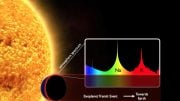
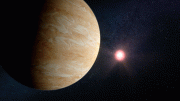
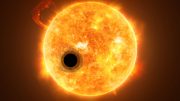
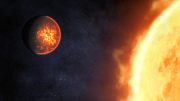
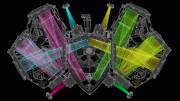
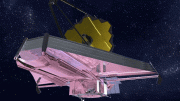
It is refreshing to see quality data analysis with the NIRISS instrument. Would it were that those who call themselves climatologists were as assiduous about displaying error bars in their data.
“Its precision spectrographs spread light out into rainbows of thousands of infrared colors.”
There is only one pseudo-rainbow. And, once again, invisible infrared (IR) radiation does NOT have any color. Only by mapping the IR wavelengths into the visible region of the Electromagnetic Spectrum can humans perceive a false-color. The apparent color depends on which IR regions or bands (3/280) are assigned to the display device’s primary colors of red, green, and blue, where the order of assignment can change the false-color.
“The extraordinarily detailed spectrum – made by simultaneously analyzing 280 individual spectra captured over the observation …”
That should be “… analyzing 280” bands or bins. Each of the 280 ‘point’ samples represents the average intensity of the IR radiation within the wavelength bounds of that particular band. Whoever wrote this press release apparently doesn’t really understand what is happening, or is trying so hard to simplify it that it becomes misinformation.
“NIRISS is able to detect [‘color’] differences of only about one-thousandth of a micron …”
They don’t make it clear whether the sample bins are that narrow or not. However, I doubt that they are because the measured intensity would be 1/8th compared to an average bin width of 0.0079 microns (2.2 microns/280 bins). Although, it appears from the first graph that bin-widths are narrower at the shorter wavelengths.
Images from the Hubble were routinely “artistically-enhanced” for public consumption, and the associated language “dumbed-down” as much as possible. The 99.9 percentile American taxpayer isn’t going to be too jazzed by massive data collection, analysis, or even break-throughs .. they want flashy new images and something mysterious and elusive to talk about – it’s the “payoff” for funding NASA. “Misinformation” is a hugely loaded word, entirely inappropriate if describing a failure to achieve laymen’s terms, when it’s obvious no insidious machinations are at work in the background. All that said, the Space Telescope Science Institute’s social media department might want to consider stricter editorial oversight going forward.
I wasn’t complaining about the imagery, but instead, the text that was associated with it. It matters not whether “insidious machinations” were at work or the misinformation is the result of incompetent science journalists. NASA is missing an opportunity to actually educate the masses as a spin off of the science mission. They have a motivated and interested self-selected audience. As a former professor, I’m all too aware that unlearning something that is wrong, is very difficult. It is far better that those responsible for teaching — whether in a classroom or a science website — take special pains to insure that what they say is correct. It can be done without resorting to jargon-loaded text, by explaining key concepts and words.
Is this water potable? My well is running a bit dry and I am looking for a second source.
TIA
The universe is infinite. So there must be an infinite number of celestial bodies belonging to an infinite number of galaxies. And then there is the endless vacuum. All and all, different chemical setups, driven by thermodynamics and whatever quantic law you can imagine. And then, there is the question of the origin of all that, for which the Big Bang gives a partial explanation, because we have to assume there was a ‘before Big Bang’.
And finally, as of the concept of a God, creator of all, I will use the french word ‘indiscible’, to express that it is forever beyond human and/or artificial intelligence. Let’s enjoy the journey with heart and decency, and those eternal mysteries will elevate us to spiritual awareness and fulfilment.